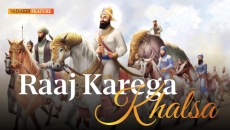Guru Sahib then initiated the Amritpaan ceremony. Amrit was prepared in an iron bowl, filled with water and patasse (sugar crystals), and stirred with the khanda (the double-edged sword) while Gurbaani was being recited. Firstly, Amrit was administered from Guru Sahib to the Panj Pyare, then, astoundingly, from the Panj Pyare to Guru Sahib himself. In a revolutionary step, their last names, the indicators of caste and division, were scrapped and replaced with "Singh" and "Kaur.” Thus, the Khalsa, a casteless community of Amritdhari Gursikhs, was born.

The option of taking Amrit was then opened to the entire congregation. Thousands embraced Amrit, joining this new order. Guru Gobind Singh Ji, by taking Amrit from the Panj Pyare, enshrined their ultimate highest authority in the Panth going forward. He practically depicted the concept of "Aape Gur Chela"—i.e., the Leader of the Panth is also a disciple of the Panth.
This ultimate authority has been evidently exercised at crucial junctures in history. For instance, during the battle of Chamkaur, despite his initial resistance to the suggestion of leaving the fortress, Guru Sahib bowed to the Panj Pyare's command, leaving the fortress to continue Khalsa’s fight against tyranny. The Panj Pyare, therefore, came to signify the embodiment of the Panth's collective will, as depicted by their commands, which are binding on the entire Panth, including the Guru himself.
Today, the legacy lives on. Five Amritdhari Sikhs, bound by the Khalsa Rehat Maryada (Khalsa’s way of life), come together to form the Panj Pyare. The authority conferred upon the Panj Pyare is exercised at the highest level in taking major Panthic decisions that impact the whole Khalsa Panth as well as in everyday matters such as leading Nagar Kirtans, administering Amritpaan ceremonies and conducting disciplinary hearings of those that have strayed from the Amritdhari Path.
Therefore, the Panj Pyare perform a dual role: they guide the Khalsa Panth and embody its collective voice. Their ultimate goal is to ensure that members of the Panth live in adherence to the Gurmat Rehat Maryada and achieve Anand (a state of true and eternal bliss) in doing so. This year, Sikh Heritage BC’s celebration of Sikh Heritage Month is thematically centered on the concept of Anand. We encourage the Sangat to attend our events to experience, explore, and discuss the depths of the multi-faceted understanding of Anand in Sikhi while celebrating the contributions of Sikhs to the social, economic, and cultural fabric of British Columbia and Canada.
WRITER BIO: Ekamjot Singh Deol is a third-year law student at the Allard School of Law at UBC, and holds an undergraduate degree in Criminology from Simon Fraser University. He is a media coordinator with Sikh Heritage BC. Sikh Heritage BC is a passionate, volunteer-driven, not-for-profit organization committed to preserving and celebrating Sikh culture, heritage, and history in British Columbia. Their mission is to shine a spotlight on the rich tapestry of Sikh heritage, fostering positive change within the Sikh community and beyond. Ekamjot's passion for preserving and highlighting his culture drives his work with Sikh Heritage BC.






